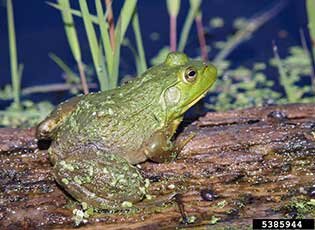American Bullfrog - Invasive Predator
/American bullfrog, adult - Photo by Russ Ottens; University of Georgia
Native to the eastern United States, the American bullfrog (Rana catesbeianus; formerly known as Rana catesbeiana) is a highly invasive species in the western U.S., Asia, Europe, and South America. A female bullfrog can lay up to 20,000 eggs at one time, compared to native frogs, which only lay 2,000 to 5,000 eggs. Bullfrogs will eat anything they can fit in their mouths, including their own young. They also aid in the spread of Ranavirus that is infecting native frogs internationally, as well as the chytrid fungus (Batrachochytrium dendrobatidis) which threatens native amphibians worldwide.
To see the current distribution of the American bullfrog in the United States, check out the USGS Nonindigenous Aquatic Species Database Point Map for the American Bullfrog.
Identification
Egg masses: Black on top and white underneath. They start as a round, basketball-size mass that flattens over time.
Tadpoles: Dark green with black dots, have orange or bronze eyes and opaque yellow underbellies. Up to 6 inches long.
Juveniles: Green to brown with small black spots, orange or bronze eyes, and a fold of skin from the eye around the eardrum.
Adults: 7-8 inches, with large, exposed eardrums the size of their eyes. Green, tan, or dark brown with dark spots and gold eyes.
In order to distinguish the American bullfrog from native frogs, be sure to look up the physical characteristics of our native species (Pacific treefrog, red-legged frog, Columbia spotted frog, Oregon spotted frog, Cascade frog, and others). A good place to start is on the Oregon Department of Fish & Wildlife’s Frogs and Toads webpage.
What should you do if you think you’ve seen an American Bullfrog?
Positively identify and eradicate bullfrogs when found in the wild. One of the most important aspects of control is to kill adult females as early in the spring as possible (when they first emerge from hibernation) to prevent the large number of eggs that they disperse. It is advised to destroy eggs when they are discovered which are easily identifiable by their large size.
In Oregon, Washington, and California, bullfrogs are classified as a controlled species and people are allowed to trap and kill bullfrogs found in these states without obtaining a permit.
Oregon: Report sightings online or call our hotline: 1-866-468-2337
Washington: Report sightings online
Additional Resources:
Invasive Species Factsheet - Bullfrog from Oregon Department of Fish & Wildlife
Stop the Invasion - Bullfrog Factsheet from Washington Invasive Species Council


